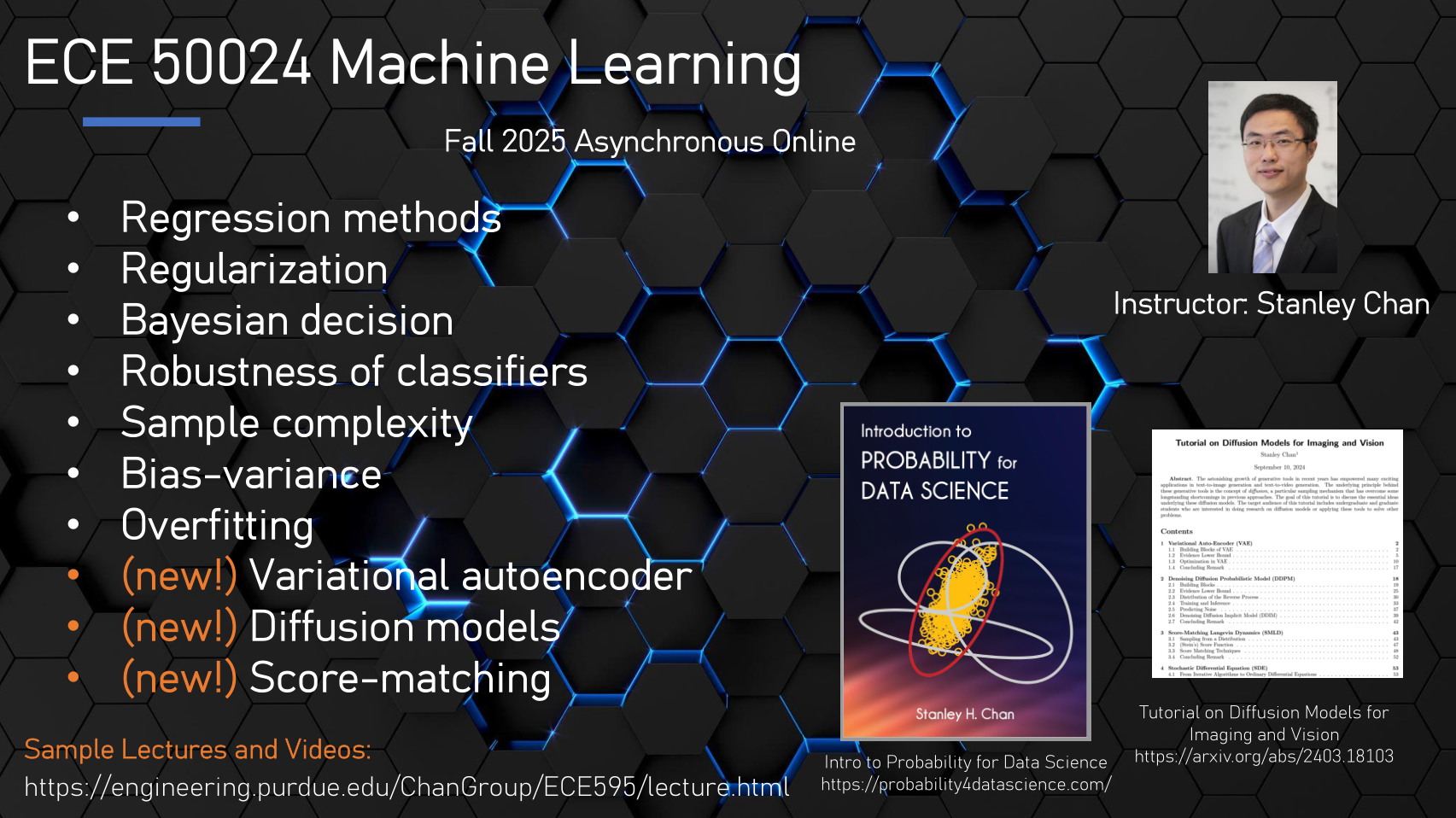ECE 50024: Machine Learning
Day One Exam (2%)
We will do Day One Exam on Jan 12, 2026.
In-person students will do this during Day 1 class.
Online students will be given a window of 24 hours to complete the exam.
There is no make up.
Problems will be based on Homework 0.
Spring 2026
Date: Jan 12, 2026 - May 02, 2026
In Spring 2025, we offer the following sections, simultaneously.
ECE 50024-002 (CRN 17000). In-Person. Smith Hall 108. MWF 12:30-1:20
STAT 59800-101 (CRN 23903). In-Person. Smith Hall 108. MWF 12:30-1:20
ECE 50024-003 (CRN 30467). Online. Special Class. Asynchronous
ECE 50024-EPE (CRN 29038). Online. Purdue Online. Asynchronous
Course Description
An introductory course to machine learning, with a focus on supervised learning using linear models.
Regression. Linear regression, loss function, optimization, gradient descent, stochastic gradient descent, least squares fitting, robust regression, ridge regularization, LASSO regularization
Linear Classifiers. Linear discriminant analysis, separating hyperplane, multi-class classification, Bayesian decision rule, geometry of Bayesian decision rule, linear regression, logistic regression, robustness of classifiers, adversarial learning
Generative Models. Variational autoencoder, denoising diffusion probabilistic models, score matching Langevin dynamics
Learning Theory. Bias and variance, training and testing, generalization, PAC framework, Hoeffding inequality, VC dimension.
Pre-requisites
Purdue ECE 302 Probability
Purdue MA 265 Linear Algebra
Purdue ECE 647 (Optional) Convex and Stochastic Optimization and Applications
Useful Background Materials
-
Purdue ECE 302 Probability https://engineering.purdue.edu/ChanGroup/eBook.html
MIT 18.06 Linear Algebra: http://math.mit.edu/~gs/linearalgebra/
MIT 6.079 Optimization https://ocw.mit.edu/courses/6-079-introduction-to-convex-optimization-fall-2009/
MIT 6.012 Probability: https://www.amazon.com/Introduction-Probability-2nd-Dimitri-Bertsekas/dp/188652923X
Stanford EE 364A Convex Optimization: https://stanford.edu/~boyd/cvxbook/
Stanford ENGR 108 Linear Algebra: https://web.stanford.edu/~boyd/vmls/
Grades
Test (80%)
There will be four tests. All tests are independent and not cumulative.
Test 1 (20%): 45-minute test during lecture. Topics for Week 1 - Week 4.
Test 2 (20%): 45-minute test during lecture. Topics for Week 5 - Week 8.
Test 3 (20%): 45-minute test during lecture. Topics for Week 9 - Week 12.
Test 4 (20%): 45-minute test during lecture. Topics for Week 13 - Week 16.
All tests are closed-book, closed-note.
Day One Exam (2%) (for both in-peson and online)
We will do Exam on Day 1.
In-person students will do this during Day 1 class.
Online students will be given a window of 24 hours to complete the exam.
Problems will be based on Homework 0.
Attendence (18%) (for In-Person Students only)
Throughout the semester.
Attend class. Answer quiz problems.
Quiz (18%) (for Online Students only)
Throughout the semester.
(For Online students only) Complete on gradescope
No more than 10 minutes each.
Most questions are short, simple, easy.
Homework (0%)
Homework will be assigned but not collected.
Solution will be distributed.
Final Exam (0%)
There is no final exam.
Project (0%)
There is no project.
Curve
We will curve the class.
Undergrad and grad will use the same curve. (This is required by the undergrad and grad committee, because this is a 500-level class.)
Roughly speaking, and subject to curves:
A: > 80
B: 70-80
C: 50-70
F: < 50
Textbook and References
There is no official textbook for this course. Please refer to the lecture
note section of the website for our lecture materials.
A few good reference books for this course are:
Introduction to Probability for Data Science, by Stanley Chan, draft. 1st edition. 2020.
Pattern Classification, by Duda, Hart and Stork, Wiley-Interscience; 2 edition, 2000.
Learning from Data, by Abu-Mostafa, Magdon-Ismail and Lin, AMLBook, 2012.
Elements of Statistical Learning, by Hastie, Tibshirani and Friedman, Springer, 2 edition, 2009.
Pattern Recognition and Machine Learning, by Bishop, Springer, 2006.
Programming
We will be primarily using Python. As such, I
expect you to have elementary programming skills, e.g., writing a hello world
program. More information and resources on how to use Python can be found in
the programming section of this website. I found
Google Colab a fairly easy-to-use
platform for Python programming. You can check this out.
Besides Python, we use optimization packages to solve optimization problems.
Of particular importance is CVX.
